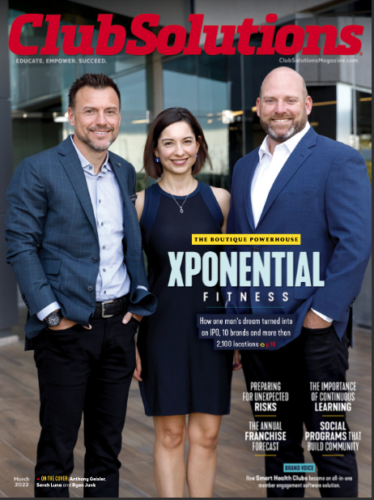Jonathan Adler and Mark Fisher "Going the Distance"
Going the Distance
With 23 clubs and counting, Sport & Health is the largest fitness chain in the Washington D.C. metropolitan area. Locally owned and operated for more than 30 years, the company is led by CEO Jonathan Adler and President and COO Mark Fisher, two dynamic leaders who have created a plan that will allow the company to grow systematically over the next five years, while also improving its existing locations.
Left to Right: Jonathan Adler, CEO; Mark Fisher, COO and President, Sport & Health Clubs, in the virtual cycling studio at Old Town Sport & Health fitness center in Alexandria, Va.
Anyone who has been lucky enough to live in or visit our nation’s capital knows that it is truly unlike any other place in the world. Brimming with diversity and steeped in history, the Washington Metro Area is comprised of innumerable neighborhood enclaves that often retain unique identities within the larger construct of D.C. Recently, Washington was named the “fittest city in the USA” by the American College of Sports Medicine – a distinction that happens to perfectly coincide with Sport & Health’s plans for expanding its presence and upgrading its clubs.
THE HISTORY
Adler happens to be a native D.C. resident, with a background as diverse as the metro area he serves. A true entrepreneur with a head for sales and marketing, Adler has achieved success in publishing and Internet start-ups over the years. He began working full time in the publishing business at the tender age of 19, while studying business at the University of Maryland. In December 2005, Adler was already a member of Sport Health when he jumped at the chance to buy the company with four other friends and colleagues who were real estate partners and fellow club members. “I was looking for a business with recurring revenue and, more importantly, one that would allow me to positively impact people’s lives,” he shares.
As the other half of this executive team, Fisher brings a wealth of industry-specific experience to the table. Having worked in clubs since graduating from college in 1982, his first real gig was at U.S. Swim and Fitness – a growing company that also served as a training ground for Bahram Akradi of Life Time Fitness and several other industry veterans. The company was eventually purchased by Bally’s, prompting Fisher to open his own club. After locating a strong market in Wichita, Kan., he opened six clubs in the area over the course of 14 years. In 1996, he decided to take some time off and sold the clubs to private parties. By 2002, after several years of owning a hospitality-based business, Fisher was ready to jump back into the industry. He knew the CEO of Sport & Health at the time from his involvement in the exclusive Young President’s Organization (YPO), and opted to take a position upon joining the company that was beneath his real experience level in order to become familiar with the many changes that had occurred in the industry. By 2006, after several promotions, Fisher had assumed his current role and was deeply involved in making the company the best it could be.
PUTTING MEMBERS FIRST
Over the years, Sport & Health has capitalized on the unique makeup of the Washington Metro Area by tailoring its approach to doing business accordingly — from programming to marketing, the clubs choose options that will appeal directly to those who live and work within a three-to-five mile radius of each location. The result is a wide variety of sports, mind-body and fitness programming for members.
“Our clubs are not cookie-cutter,” says Adler. “We choose the programming for each club by analyzing extensive demographic information which outlines the preferences of each club’s membership base – and the surrounding community as a whole.” For example, programming in one club may be more family-oriented, while programming at another location would be more focused on attracting active businessmen and women. According to Adler, being a locally owned and operated company allows them to more easily manage this variety, especially since both he and Fisher believe in getting out of the office and into the clubs on a regular basis. “I don’t manage from my office – our entire management style is very inclusive,” states Fisher.
Technology has also played a leading role in allowing Adler and Fisher to properly evaluate the performance of the clubs’ many programs. When Adler assumed his position at the helm of Sport & Health, the company was still using an outdated DOS system that was very slow to generate reports. They turned to CSI for help, and systematically updated the company’s hardware and software. Now, they are using a real-time system which everyone has access to, that can easily track and determine member preferences – an essential component in managing multiple locations that offer such a wide variety of programming. “We can look at the percentage of our membership that is engaged and determine how it is affecting retention,” Adler says.
Perhaps one of the most important ways Sport & Health stays in contact with members and keeps a finger on the pulse of the communities it serves is through systematic communication with members when they are outside of the clubs. “We are big believers in e-mail and using online technology for keeping in touch with our members,” says Fisher. According to Adler, they reach out to all members on a monthly basis – either to let them know what’s going on in the clubs, or to ask them for feedback, or both. In addition, spot surveys are conducted quarterly and every member is surveyed annually using in-depth metrics designed to measure all aspects of each club.
Community involvement is another key component of staying in touch. Sport & Health has raised more than $1 million in the last few years for charity, and managers and employees are expected to get out into the community where their clubs are located. This grassroots approach also applies to the company’s guerilla marketing choices, which Adler says have driven down the cost per sale while driving up closing ratios. And, the company’s record sales the last few months are solid proof that this technique is working. “Our member referrals are up because we are actively encouraging members to bring new people in, while our employees’ involvement in the communities has gone a long way to build trust,” Fisher shares. Adler agrees, stating, “With my business and marketing background, I’m a big believer in the power of the Internet and using marketing techniques that involve an unconventional approach, relying on time, energy and imagination instead of a big marketing budget,” he says.
HANDS-ON MANAGEMENT STYLE
According to Adler and Fisher, another major component to the success of Sport & Health has been the company’s outstanding Senior Leadership Team, general managers and employees – basically, the people who are out in the clubs running the show every day. “The most important thing to remember is that companies are always driven by the people who work there,” says Adler.
When asked how they have been able to locate and foster such a strong team, Fisher says they looked for “drivers” and were fortunate to find many already within the company. “We want to be the premier employer of fitness personnel in the region,” he shares. Adler agrees, stating, “We are both a great place to work and a tough place to work – our interview process is very detailed; our general managers typically go through seven or eight different interviews prior to joining our team.” In addition to exceptional management, Sport & Health prides itself on the quality of its personal trainers; they accept fewer certifications than many other clubs, and all new hires must do an audition and interview with multiple general managers.
According to Adler, they also pay above average in order to attract and retain the best employees. This has allowed them to feel comfortable empowering managers and giving them real responsibilities – they are expected to understand what it takes to operate all aspects of the business. “We expect them to know members’ names and to spend three hours a day at the front desk, but we also expect them to be involved in discussions on marketing, pricing, compensation, etc.,” says Adler. “Our managers have a very strong influence and can really impact their club’s performance,” adds Fisher.
Neither Adler nor Fisher believe in a “top down” management style. Instead, both prefer to have as many heads as possible contributing to the betterment of the company. “You have to align your goals and expectations by developing a clear purpose, mission and value statement,” Adler shares. Fisher agrees, adding, “We have shifted the focus of the company culture and now everyone is committed to, and focused on, being a progressive, driven, energized health and fitness corporation.” To them, this means becoming better than they were last year, last month, last week, even yesterday. In practice, having regular inter-club competitions is a key part of this philosophy. Achievements like having the highest retention rates, the best member surveys or breaking a sales record do not go unnoticed, and rewarding positive change creates urgency and fosters a dynamic, high-energy environment.
More than 20 years ago, Fisher’s mother gave him a book that has now become an integral part of the culture at Sport & Health. An outwardly unassuming volume, “Rhinoceros Success,” by Scott Alexander is often mistaken for a children’s book at first glance. Its content, however, illustrates the importance of being “like a rhino” in life by taking charge and staying focused on your goal, while also being unafraid, thick-skinned and unstoppable in the face of challenges. “Today, this philosophy is enmeshed in the company – our screen savers are rhinos, clubs that “crash through” their sales goals get “Rhino Awards” and our conference room is called the “Rhino Room,” says Fisher. And it’s obvious that both he and Adler are willing to walk the walk. “Everyone needs to know what good performance looks like,” Adler says. “We are in front of them enough and are consistent enough to set the example.”
FIVE-YEAR PLAN
In case you haven’t heard, Sport & Health received $25 million in financing through PNC Mezzanine Capital and CMS Mezzanine Fund earlier this year, which has allowed the company to restructure senior debt — enhancing its capacity to grow and improve its network of clubs. Over the next five years, Sport & Health will continue to upgrade existing locations and has plans to acquire or build three new clubs per year in the D.C. area. For new clubs, they have a 20,000 square foot urban model and a 40,000 square foot suburban model, both of which have the capacity to provide the variety members have grown to expect. – CS
Keys To Success:
BECOME incredibly efficient at managing expenses, but always make sure that any changes will not have a negative effect on the member experience. Instead, focus on getting better terms from vendors and doing away with unnecessary waste.
INCLUDE key employees in the decision-making process. Get them involved in finding solutions to your club’s challenges – they are on the front lines of your business and will have important insights to share.
MOTIVATE your staff by creating inter-club competitions and rewards for outstanding achievement.
KNOW your community and service its needs. More people today are joining clubs that are conveniently located close to home or work, so understanding what your club’s dominant demographic really needs will help you keep members happy.
FIND ways to get managers and employees involved in community events. This is a great way to earn trust, and remember: You get what you give!
ASK your members to tell you what they think. Staying in touch with members and actively engaging them in the direction your club takes is paramount to remaining relevant in their lives.












































































